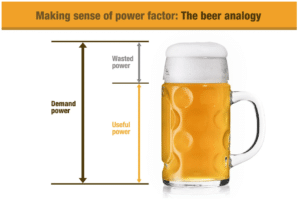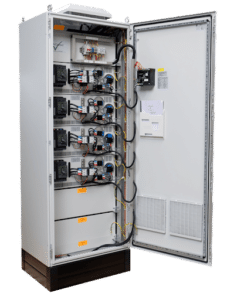by Chris Hargreaves | Jan 24, 2023 | News, Solar Power

As energy prices continue to surge and volatility reigns in the market, could now be the time for your business to bask in the cosmic power of solar?
Take a moment to factor in the potential cost savings, reputational benefits of clean energy, and the carbon savings your business can achieve – and it’s definitely worth taking a look. Or maybe even a second look if you haven’t considered it for a while.
Solar landscape changing
Total Utilities Director Chris Hargreaves said, “The landscape of how a company can integrate solar is changing and there are more options becoming available.
“While we continue to provide solar audits, and can design and install fully customised solar power systems, as well as advise on how to quantify carbon savings – we’ve also developed a hybrid solar option for our clients. This solution is a power procurement option that incorporates buying solar direct from a solar farm.”
Hybrid solar solution
NZ’s first solar farms aren’t expected to start connecting to the grid until somewhere between August or September this year, but Total Utilities’ hybrid plans enable clients to buy direct from a solar farm now using a power purchase agreement. This can then be combined with supply from their traditional energy retailer.
The solar gets supplied to the retailer, for example Mercury or Genesis, who can package it all up together and bill a hybrid price. Using this procurement solution, Total Utilities creates significant cost and carbon savings for our clients.
As Chris explained, “Some of the ten year prices we’re getting from solar generators are 11 cents a kilowatt. When you compare that to what power suppliers are delivering during peak periods – some months it’s close to 30 cents per kilowatt. So you can achieve quite a decent amount of savings with these hybrid plans.”
To simplify things, let’s take a look at three basic models of power procurement:
Here’s the traditional – vanilla if you like – method of power procurement direct from a power supplier AKA Meridian, Mercury et al.

This second model enables you to use your own generated rooftop solar topped up with power purchased from your power company in order to meet your total power demand.

The third, hybrid option means us arranging contracts where clients buy solar direct from solar farms to use in combination with your supplied electricity.

“The beauty of buying solar as a commodity is that even if you relocate your business site, you can still keep buying solar as it’s not tied to your location,” said Chris.
“So buying solar from a farm will be particularly attractive for customers who lease their premises or are likely to move – or for those who just don’t have a particularly feasible site.”
An array of solar services!
Total Utilities also provides solar feasibility audits to help identify whether actually installing solar power could be a good option for you. Our recommendations include a detailed analysis of cost benefits of solar versus implementation costs.
Chris explained that installing a solar array can lead to up to 25 to 40% reduction in energy usage, which results in reduced carbon liability from grid supplied energy. Then there’s the savings of 10 to 30% on total electricity cost – although this varies depending on how much energy is used at night and what the energy costs are for the given site.
This is a big saving when you consider that electricity is likely to be one of the top three expenses a business faces.
Boom time for solar
It appears that after some delay, the solar boom is finally on its way in New Zealand – following in the footsteps of other countries like Australia, where solar has almost 30% market share, and the US, which is aiming to generate 50% of its energy from solar by 2050.
Whether you’re making it or mixing it – solar is shaping up to be the way of the future to save carbon, money and the planet.
Sign up below for Total Utilities Market Commentary to receive all the latest market news and insights.

by Chris Hargreaves | Dec 15, 2022 | News
Who needs Santa’s Little Helpers when we have Christmas new recruit Gary Gonsalves, and his Robotic Process Automation (RPA) army?
Gary joined the Total Utilities team this month as Energy & Business Improvement Manager. He will be implementing RPA to speed up business processes and improve customer experience.
Gary is no stranger to Total Utilities, having already worked in a consultant capacity over the past three years. His new, permanent role will see him exploring key areas where RPA can be implemented to take the business to the next level.
Total Utilities has already integrated bot technology under Gary’s stewardship, and RPA has enabled us to cut manual tasks such as data entry and repetitive work. Automation frees up staff to focus on important tasks, so that we can increase productivity and make ourselves more readily available to customers.
Key benefits of Gary’s work to date include enabling the business to process data more quickly, accurately and efficiently – resulting in a streamlined energy procurement process.
Gary explained his decision to move into a permanent role with Total Utilities was easy given his experience of working with the management team: “I was immediately struck by the integrity of people like Jonathan and Chris and the way they conducted themselves and ran the business,” he said.
“They were not afraid to experiment with new technology and explore future developments. That was attractive to me.”
Next steps for Gary will include exploring other key areas where RPA can be implemented to make things easier for our customers, whilst also enhancing employee experience. He will also be looking at the bigger picture to see how we can centralise tasks and further improve business processes.
Outside of work, Gary is a keen gym bunny and hits the treadmill at ridiculous o’clock in the morning! He is always on the go and loves exploring new activities with his seven year-old son and wife.
Please join us in welcoming Gary to the team.
Sign up below for Total Utilities Market Commentary to receive all the latest market news and insights.

by Chris Hargreaves | Dec 15, 2022 | News
Meet Jonathan Stewart, our newly recruited Data Wrangler, who will be wrestling our raw data into ‘practically perfect’ order, and enabling us to create vital energy insights.
Jonathan joined the Total Utilities team last month and comes from a market research background, with some 20 + years of experience in the field.
His previous role as a Database Specialist involved creating online reports and dashboards, restructuring data and generating market research databases – skills that will all be highly transferable to his role with Total Utilities.
Jonathan will be assisting the team to ensure that all data is reliable, accurate and of the highest quality.
When asked what attracted him to working for Total Utilities, Jonathan said the deciding factor was our strong focus on assisting customers with sustainable energy and decarbonisation solutions.
With research showing that more and more people are choosing to work for companies that make sustainability and the environment a priority – Jonathan is a living, breathing example of this!
Jonathan brings a background in data, attention to detail, and a willingness to learn to his new role. “I’ve only been with Total Utilities for a couple of weeks, so I can’t say I have a typical day just yet. I’m mostly in the learning stage at the moment,” he said. He is motivated by a strong desire to do a good and thorough job.
When it comes to home life, Jonathan is keen to enjoy every moment with his family and friends. He is also a keen music fan with a costly interest in collecting limited edition vinyl – the rarer the better!
Jonathan is also a keen baker, so here’s hoping the team will get to enjoy some of his tasty treats… if he has any time between wrangling data!
Welcome to the team Jonathan!
Sign up below for Total Utilities Market Commentary to receive all the latest market news and insights.

by Chris Hargreaves | Nov 21, 2022 | News
Analysis of recently released results from the 2022 ‘CFO Sustainability Snapshot Survey,’ confirms that collaborating with sustainability experts and peers is the best way forward for businesses to learn, build sustainability capability and create meaningful impact.
The 2022 CFO Sustainability Snapshot Survey carried out by Deloitte, the Sustainable Business Council, and Toitū Tahua: Centre for Sustainable Finance, found progress towards sustainable action remains largely ‘stagnant.’
Respondents said the wide scope of sustainability issues is difficult to navigate and their organisations struggle to cope with the scale and complexity of the challenge.
Barriers to taking action
Survey results also indicated that barriers to action include a lack of resource or capability, an absence of examples of good practice, and limited legislative requirements to guide them around areas to prioritise.
Total Utilities Director Chris Hargreaves said of the survey, “The results underline what we are seeing on the ground with our clients. Organisations and senior leadership are struggling to find a way forward and often don’t know where to start with measuring and then reducing their carbon footprint.”
“CEOs and organisations are grappling with calculating the cost of taking action versus the cost of doing nothing. However, addressing carbon is becoming a real business problem – not an optional extra and creating a low carbon economy requires considerable planning.
“Business leaders will need to be adaptable and flexible to meet the Government’s emission budgets and reduction plan and they will need to have a plan to mitigate risks associated with it.”
Advantages of decarbonisation stack up
Chris says despite the lack of progress there is still room for optimism, with the survey highlighting key drivers for sustainable action being values-based rather than solely based on compliance or a cost versus profit exercise.
A total of 66% of CFOs identified ‘doing the right thing’ motivates sustainable action in their organisation. ‘Competitive and reputational advantage’ (62%) and ‘investor and shareholder demands’ (37%) rounded up the other top three drivers for action.
“There is a growing realisation that the benefits of addressing carbon now are huge in terms of mitigating against the rising cost of carbon, as well as protecting brand and reputation, with more customers turning to sustainable companies,” said Chris.
Reach out to our experts
Science tells us we need net zero emissions to limit temperature rises to 1.5°C – giving us the best chance of preventing irrevocable changes to the climate. This survey underlines the fact that collaboration with experts and peers is essential to making meaningful progress towards this target.
Total Utilities has worked in the NZ energy market for well over 20 years and specialises in assisting organisations with the decarbonisation process and putting together carbon reduction plans.
Chris explains, “We use science-based methodologies to create your pathway to net zero, whilst ensuring a stakeholder led approach. We can also help reduce your business risk by adhering to today’s environmental regulations and preparing you for future legislation.
“Funding challenges are often a significant roadblock to businesses taking action, but the benefits of future proofing your business and cost saving over time help offset this. We can also help you identify cost saving and revenue opportunities that will have a positive effect on your productivity, profits and performance.
“I’d advise senior leaders and CFOs to reach out and talk to one of our experts today. There’s no need or advantage to doing this alone.”
Contact Total Utilities to find out more about our services and solutions.
Sign up below for Total Utilities Market Commentary to receive all the latest market news and insights.

by Chris Hargreaves | Nov 14, 2022 | News, Power Factor
Ever felt ripped off after being served up a beer with more head than you can shake a stick at? Then take a moment to consider how power wastage from your business’ equipment is as useless as the froth on your over-fizzed brew.
But what on earth has power factor got to do with beer I hear you say? And more importantly, what even is it?
Power factor in a nutshell… or a pint glass
Power factor is basically a measure of how efficiently your business sites use power supplied by your network distributor. Poor power factor = poor power efficiency and increased charges.
But for a more detailed, um, ‘scientific’ explanation, let’s get back to that beer:

Beer = active power (kW) – the useful power, or the liquid beer is the energy doing the good work.
Foam = reactive power (kVAR). This is wasted or lost power. It’s the energy being produced that isn’t doing any work and is annoyingly inefficient.
The mug = apparent power (kVA). This is the demand power, or the power being delivered by the utility.
So, the more ‘foam’ on your power factor, the more power wastage and the higher your inefficiency. Poor power factor is bad news for your business, your carbon footprint, and the environment.
Power factor is expressed as a percentage – the lower the percentage, the less efficient your power usage.
For example, equipment with a power factor of 1 is using all the power supplied to it. Big tick. Generally, a power factor of 0.8 or above is considered good.
However, if your power factor is lower than 0.8, it should be corrected to save on consumption and comply with the requirements of the electricity network operator.
Paying hand over fist for power
Total Utilities Director Chris Hargreaves explains, “Your power supplier provides electricity to meet your demands. Therefore, if your apparent power needs are high in order to compensate for poor power factor, you – the customer – will end up paying through the nose for it.
“For some larger customers, power suppliers might even take the largest peak and apply it across the full billing period. So you’re paying a very high price indeed for that froth on your beer!
“Poor power factor can also cost your business through direct penalty charges applied by many electricity distributors in New Zealand. This combined with charges for apparent rather than actual power can result in sky-high utility bills – particularly in this current climate where the cost of power is going through the roof.
“Conversely, by reducing the amount of energy your site requires at any one time, you reduce demand and the cost of supplying energy to your site.”
So, how do I get a handle on my business’ power factor?
Before you start to tackle a power factor problem, it’s important to get a measure of how efficient your current equipment actually is.
Total Utilities provides power factor audits – complete health checks of the overall quality of your electrical network. Our power factor audits identify problem areas and suggest opportunities for improvement in order to maximise your energy savings, mitigate faults and increase system reliability and efficiency.
Total Utilities can save you money with power factor correction
If a problem is identified during our audit, installing power factor correction is a great option to reduce your demand charges.

Total Utilities works with Rotorua based power factor correction specialists KVAr Correct, to provide complete, custom, and ready-to-go power factor correction solutions, plus ongoing monitoring and maintenance. These modular systems are custom designed to meet each customer’s need, ensuring the best return and no wasted capacity.
So, if you’re looking to reduce costs and increase energy efficiency (and let’s face it, who isn’t?), maybe now’s the time to look into your power factor? Use less. Pay less. Reduce your carbon footprint.
It’s a win-win for your business, your bottom line and the planet.
Sign up below for Total Utilities Market Commentary to receive all the latest market news and insights.










